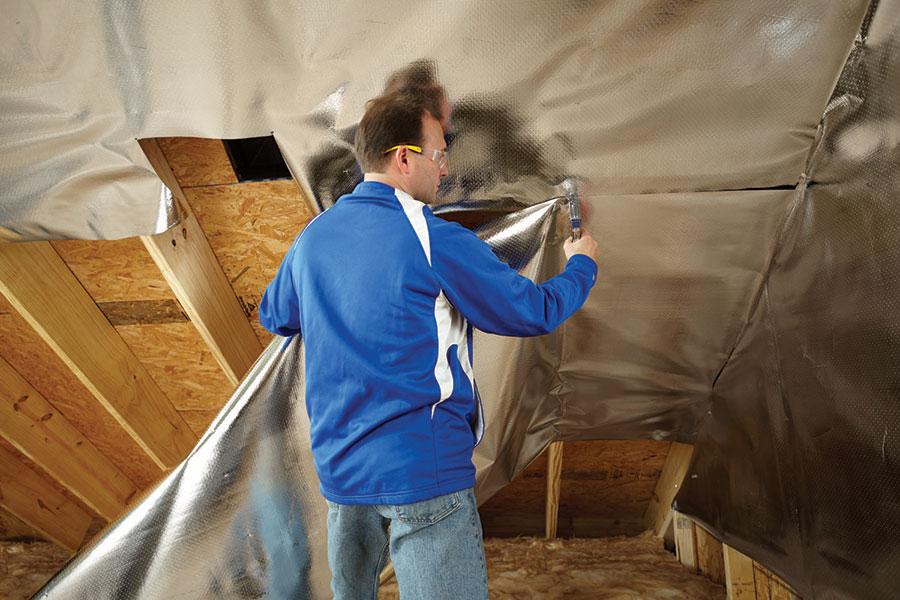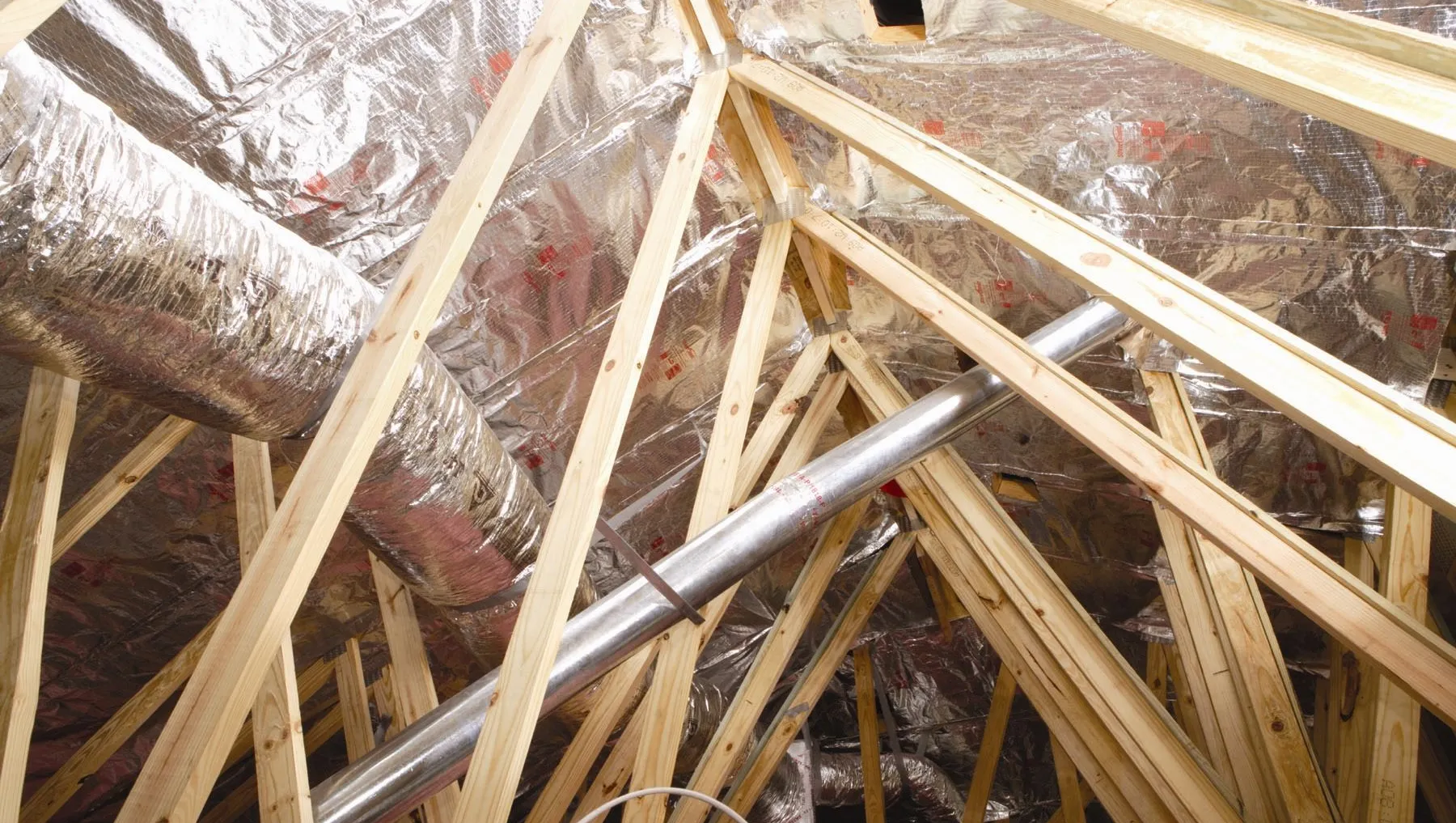Gaining energy efficiency and cost savings through insulation is a top priority for homeowners, builders, and business owners. Radiant barrier technology effectively solves these issues by blocking heat transfer from a structure’s roof or exterior walls. With their reflective properties, radiant barriers block up to 97% of the sun’s heat from entering a roof or walls.
This article provides an overview of what radiant energy barriers are, how they work, the different types available, common uses, and installation tips to consider. From insulating your attic to reducing the load on an air conditioning system, there are numerous benefits of using radiant barrier technology.
What Is A Radiant Barrier?
Radiant barriers are thin sheets of aluminum-foil-faced insulation materials that can be laid over existing insulation materials in the rafters of an attic or between walls and ceilings. They help block radiation or UV rays and help reduce radiant heat gain. If they don’t stop them, they’ll penetrate heat objects and spaces like the inside of your attics.
The radiant is designed not to absorb heat and reflect radiant heat. However, they aren’t capable of reducing heat conduction like thermal insulation materials. A radiant barrier is anything capable of reflecting heat to the source. Also, it keeps an object from getting heated by UV rays and radiating its own heat.
How Does It Work?
During the hottest summers, the sun’s heat enters your home through transparent openings such as windows or surfaces, including your home roof and walls.
There are three ways of heat-moving conduction, convection, and radiation. Let’s explain them one by one.
- Conduction: Heat is moved from the hottest plants to the coldest area on the surface, and when the sun rays enter your roof or any transparent opening, they move inward.
- Convection: When you heat the gas-liquid, its density decreases, and rises. The hot air inside your home moves from rooms to your attics.
- Radiation: When the heat radiates out from any heat source. It moves in a straight line, and the objects in its path absorb its warmth.
When the hottest sun rises during summer, its radiations reach your home’s roof and absorb it, which is why you feel extremely hot inside your home.

If a homeowner still needs to install radiant barriers, the heat will enter the home through the roof and reach the attic.
When you install a radiant barrier, it’ll help in blocking heat transfer. A radiant barrier blocks the radiation going inside your home. Rays cannot be passed through the reflective surfaces, so the heat bounces off.
In this situation, the radiant barrier acts like an aluminum surface between your hot roof and cool living or bedroom. If your home is heated, insulating radiant barriers is better.
Now you need clarification, what’ll happen during winter? The radiant barrier will work the same way, preventing heat from escaping your home and diverting it to other areas. In this way, your home stays warm.
A radiant barrier works best when the sun is perpendicular to the sun’s energy striking it. Moreover, when the temperature difference is greater between the sides of the barrier material, the benefits of a radiant barrier will provide greater benefits.
In addition, radiant barriers work more perfectly when insulated in hot climates than in cool temperatures, mainly when your cooling air ducts are located in attics. Some experts have even claimed that radiant barriers can minimize the cost of cooling by up to 5%-10% when you use them in hot, warm, and sunny weather conditions.
Radiant Barrier Is Used For:
To use the radiant barrier insulation, you need to install it in a way that allows for an air gap of at least one inch. This creates a climate-controlled environment that blocks and reflects up to 97 percent of the sun’s infrared rays from entering your home or building.
- The radiant-barrier material helps reduce cooling costs by reducing the heat transfer from the roof and walls into the house. This reduces summer cooling costs and helps keep your home warmer in winter.
- It can also help reduce or eliminate mold and mildew in areas of high humidity, such as bathrooms, kitchens, basements, attics, and garage floors.
- The reflective surface of the radiant barrier can also reduce humidity levels by reflecting away heat and moisture.
- Moreover, the radiant barrier also has a wide range of applications other than those mentioned above. For instance, it is often used to line agricultural buildings to improve the environment for livestock, protect against vapor transmission, minimize dust accumulation, and reduce energy costs associated with cooling.
- It is also used in cars and boats to reflect sunrays away from the vehicle, thus reducing interior temperatures. Also, it can be applied to various surfaces, such as plastics and steel, to reduce heat transfer and enhance overall efficiency.
Types of Radiant Barriers
Different types of radiant barriers have different advantages when discussing durability, strength, water, vapor permeability, and flammability. The main types of radiant barriers include:
1. Aluminum Foil Laminates
Aluminum foil laminate refers to the layers of film foil that consist of a thin layer of the aluminum sheet inside. This type of radiant barrier is designed using plastic films, kraft paper, plywood roof sheathing, and a laminated foil top.
The laminate is thicker, and however, with the type, it can sag due to its heavy weight. They can also undergo delamination, and bubbles accumulate when exposed to higher temperatures.
2. Aluminized Plastic Films
This type of radiant barrier contains a thin layer of plastic aluminum particles applied as a film through a vacuum process. You can understand this by keeping in mind the shiny reflective foil inside a bag of chips.
Aluminized plastic film radiant barriers are more resistant to extreme weather conditions, whether hot or cold, than the laminate type.

Process Of Barrier Usage
You can insulate radiant barriers throughout your home, such as in your rooms, crawl spaces, and attics. Look at the most popular and easy methods for radiant barrier insulation.
1. Attics
If you are installing it for attic use, here are something you need to follow:
- Rafter/Truss installation: Drap your radiant barrier over the trusses making sure the foil faces downwards.
- Under Or Pre-Laminated To Roof Sheathing: Place the radiant under the roof’s sheathing along with the foil, the side of the foil facing down.
- Horizontal Installation: Apply the radiant barrier above the ceiling directly or existing ceiling insulation.
However, if you want to combine radiant barriers with other insulation options in your topic, remember a few things:
- Observe your ceilings, materials, and insulation for any sign of moisture. If you find any indication regarding moisture, remove the reason for the moisture before applying the radiant barrier.
- Place radiant barriers above the other insulation without stapling or taping it. Make sure there is no tight contact with the material under it.
- Make sure that grind or dust doesn’t accumulate on the top of your radiant barrier.
- Remember the ASTM standards for smoke, flame spread and smoke development, and water vapor transmission.
- Verify the radiant barrier characteristics along with local building codes.
2. Walls
If you want to install radiant barriers in the walls of your building or home, keep in mind these points:
- Make sure that each wall is properly insulated. Using furring strips, remove the interior structural walls and outer skin one at a time.
- Once this is done, wrap the wall with a reflective insulation material such as aluminum foil or foam board.
- Make sure that the reflective side faces out into the vented air space, and staple the material in place. This helps to create a barrier that will keep your home warm in the winter and cool in the summer.
- Additionally, it will help to keep your energy costs down by ensuring that heat is not escaping through ill-insulated walls.
- It may be necessary to cut holes in the radiant barrier for plumbing and wiring. Make sure that any openings are sealed with caulk or spray foam insulation to create an airtight seal.
- Check all connections and seams on your radiant barrier to ensure they are properly connected before closing the walls.
3. Floors
You can install the radiant barrier above your cool basement or crawl spaces to take advantage of its warmer properties. Also, you can enjoy its blocking ability of moisture from entering your home. There are two methods of installing such radiant barrier insulation:
- Wrap the radiant barrier beneath the floor joists. Keep open a single reflective space.
- Lay the radiant barrier between the two joists. Include sheathing and leave two different reflective surfaces.
Things To Remember While Installing Radiant Barriers
It’d be better to hire professionals from a company because they are experts and know the ins and outs. You’ll get the best results if you install the radiant barrier accurately. However, if you can do it yourself, here are some tips you need to follow. Thoroughly read the mentioned instructions and follow them properly for the best results.
- Apply the radiant temperature in a place where it remains warm enough without reaching the dew level temperature. It means to place it where the temperature is 17-18°C and where the relative humidity and good ventilation.
- If you install a radiant barrier in your newly constructed home, it’s better to drape the rolled foil with its foil face down between the rafters. It’ll help in minimizing the accumulation of dust on the reflective surfaces. The best time to install it is before you place the sheathing surface.
- If the roof is on the building or home, the radiant barrier is to the bottom of the rafters in the attic.
- Avoid applying the radiant barrier insulation on top of attic floor insulation because there is a possibility of trapping moisture.

Radiant Barrier Vs. Reflective Insulation
These terms are frequently interchangeable. However, that’s not true. They have some similarities but also have a few clear differences.
Both insulation options have similarities:
- They both contain a metal surface that helps them block heat gain and loss.
- Strengthen energy efficiency.
- While you are installing, using the air space will increase the insulation value while you are installing.
- They have the same properties as the name implies. They can reduce heat gain and loss and have no inherent R-value as they cannot absorb heat and transfer it across air space.
- You’ve to keep them dust free if you want good results.
There are differences as well, including:
- Radiant barriers contain a single thin surface of the metalized film with a reinforced middle part known as a woven scrim. While installing, facing an enclosed air space, the radiant barrier turns into a barrier system or reflective insulation with a measurable R-value.
- Reflective insulation has a middle part that is made up of foam, bubbles, or fiberglass enveloped by two or more surfaces of foil. The foil surfaces aren’t able to touch due to the structure of foam and bubbles. This permits the air to get closed inside, which helps increase the R-value.
- Another difference is that reflective insulation prevents condensation and moisture, particularly in steel and metal buildings.
FAQs
1. Does Radiant Barrier Insulation Work?
It functions as an additional layer for preventing heat from your home. However, a radiant barrier foil isn’t the same as attic insulation. Therefore, it isn’t capable of reducing heat conduction like the thermal insulation materials. It’ll act as a supplement to the insulation that you may have in your attic. Also, the barrier works best when installed directly with the attic’s ceiling and floor.
2. Do Radiant Barriers Help In Winter?
Yes, it helps keep warm air in the winter and helps in solar radiant heat transfer during the hottest days. With the barrier in place, your home will stay much cooler during the summer months when temperatures reach their highest. In winter, it’ll keep warm air from escaping outside and minimize energy costs associated with home heating.
3. Are Radiant Barriers Easy To Install?
Yes, radiant barrier materials are fairly easy to handle. Installation instructions may vary depending on the type of radiant barrier you purchase. Many come with detailed diagrams and directions that make the process quick and easy. However, if you are unsure whether or not you can handle the installation, it is always best to contact a professional for help.


